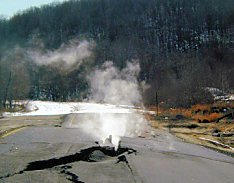 Perhaps this is one of those stories that many people know, and I’m just late to the ranks of the informed. Whatever the case, I first heard about it today:
Perhaps this is one of those stories that many people know, and I’m just late to the ranks of the informed. Whatever the case, I first heard about it today:
In the mining town of Centralia, in northeastern Pennsylvania, the trash in the landfill was burned weekly. One day someone lit the trash on fire, and it accidentally ignited an exposed vein of anthracite coal. The fire grew.
That one day was in 1962, and the fire is still out of control.
Centralia has been on fire for 45 years.
The fire follows the deposits under the town, periodically getting a blast of oxygen when the ground opens. Many buildings were long ago swallowed; smoke billows from cracks in the highway; carbon monoxide fills the air in places. They’ve rerouted a highway around it.
 They tried to put it out for 20 years or so, and finally gave up and condemned the town (eminent domain, and the idea that the government did this to get the mineral rights has some traction), spending $42 million to relocate residents. According to the excellent Wikipedia article, 12 people still live there, the town’s four cemeteries are still well-maintained, and the church holds a service every Saturday night.
They tried to put it out for 20 years or so, and finally gave up and condemned the town (eminent domain, and the idea that the government did this to get the mineral rights has some traction), spending $42 million to relocate residents. According to the excellent Wikipedia article, 12 people still live there, the town’s four cemeteries are still well-maintained, and the church holds a service every Saturday night.
There are no plans to try to extinguish the fire in the near future. The vein of coal fueling the fire is large enough to sustain it for the next 250 years.
More here:
- Fire in the Hole, excellent short fiction based on Centralia
- Damn Interesting story (also, thanks for the above images)
You might also like:
- No, everyone who voted for Trump is not complicit in storming the Capitol
Note: I don’t recycle Facebook content here often, but I decided to make an exception this morning. … - Media bias is to be dissected, not bludgeoned
As part of my university curriculum, I studied media bias extensively. With a degree in communicati… - Environmentalists: hyperbole is bad for business
I’m watching Asia’s Deadly Dozen, about sharks and snakes and such, on National Geographic HD. Good … - Margaret, blue laws, and what Christianity is
Good Lord willin’ and the creek don’t rise (-5), I’m going to have a leisurely catch-up lunch with m… - Who’s a slob? He is. Who’s the worst slob? She is.
So when it comes to sexism and accusations of same, what kind of person are you? If I wrote somethin…

I first learned about this back in the late 70’s while I was in college. I had a student job at the U.S. Geological Survey and I worked in the Coal Branch. We students did all the mundane work like making map overlays of the various coal reserves in WVA. I remember looking at a map of a coal mine from the 60’s which showed a portion of the coal mine marked off as “fire area.” I thought this was an area where there used to be a fire or something. I asked my boss how I was supposed to mark this on my overlay and he told me mark it as “fire area.” He saw my puzzeled look and explained that there was an active fire in that area. I pointed out that the map was over 10 years old. He explained to me that those fires continued to burn because there was no way to put them out. I was stunned and learned why “fire areas” became features on a map just like sink holes and what not.
Bob230
Yes I read about that very recently. I think it was in a novel, but I can’t remember which one!
Excuse my language, but that shit is fucked up!
That’s crazy!